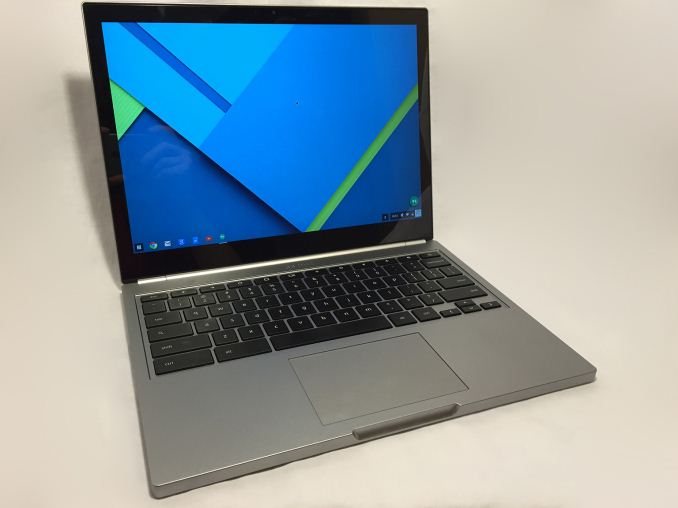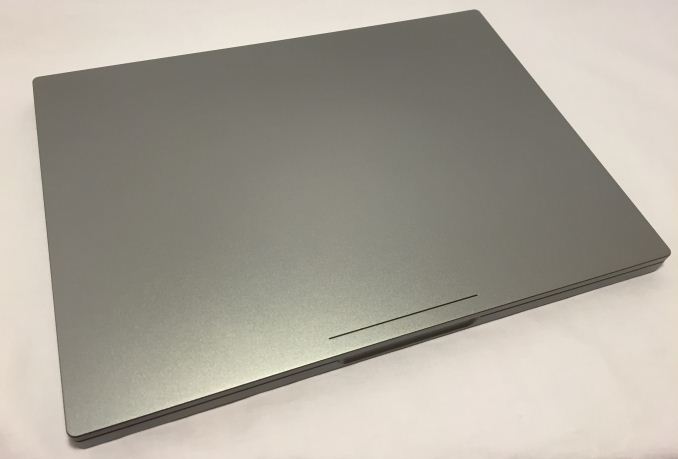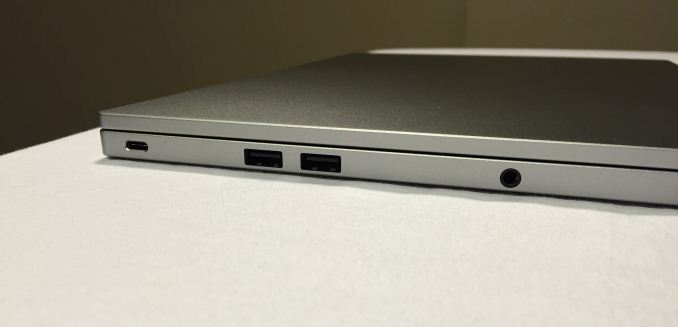The Chromebook Pixel (2015) Review
by Brandon Chester on March 16, 2015 8:00 AM EST- Posted in
- Laptops
- Chrome OS
- Chromebook
- Chromebook Pixel

Google's Chrome OS has always been similar to Microsoft Windows in how one company provides the operating system for many different manufacturers to use on their own devices. But two years ago, Google decided to create a Chromebook which was solely Google branded and designed. Although Chromebooks typically aim at the inexpensive part of the laptop market, this Google branded Chromebook had specifications that put it in line with high end Ultrabooks, and an equally high price tag. It was the original Chromebook Pixel, and its name referred to its 2560x1700 IPS display. At 239ppi it had the highest pixel density of any laptop in the world when it was released, and the rest of its specs were also impressive. In our original review of it, we concluded that it was an impressive laptop, but that its starting price of $1299 was quite a barrier to entry. In addition Chrome OS was more limited at that time than it is today.
That brings us to the new Chromebook Pixel which was released just last week. At first glance, you would be hard pressed to tell the difference between this new model and the old one. It has a similar high resolution display, and the same aluminum body with flat edges. But a look at the sides of the chassis will reveal a pair of highly versatile USB Type-C ports, and a figurative look inside will show one of Intel's new Broadwell CPUs which enables high performance and stellar battery life. Before we dive into the new Chromebook Pixel, I've compared it with the original Pixel from 2013 in the chart below.
| Chromebook Pixel (2013) | Chromebook Pixel (2015) | Chromebook Pixel LS | |
| Dimensions | 11.72 x 8.84 x 0.64" (297.7 x 224.5 x 16.3mm) | ||
| Mass | 3.35 lbs (1.52kg) | ||
| CPU | Core i5-3337U (2 cores + HT) | Core i5-5200U (2 cores + HT) | Core i7-5500U (2 cores + HT) |
| L3 Cache | 3MB | 3MB | 4MB |
| Base CPU Clock | 1.8GHz | 2.2GHz | 2.4GHz |
| Max CPU Turbo | 2.7GHz | 2.7GHz | 3.0GHz |
| GPU | Intel HD 4000 | Intel HD 5500 | Intel HD 5500 |
| System Memory | 4GB DDR3L-1600 | 8GB LPDDR3-1600 | 16GB LPDDR3-1600 |
| Storage | 32GB SSD | 32GB SSD | 64GB SSD |
| Display | 12.85" 2560x1700 IPS LCD | ||
| Battery | 59 Wh | ||
| Ports | 2 x USB 2.0, Mini DisplayPort, 3.5mm audio | 2 x USB Type-C, 2 x USB 3.0, 3.5mm audio, SD card | |
| Connectivity | 2x2 802.11a/b/g/n + BT 3.0 | 2x2 802.11a/b/g/n/ac + BT 4.0 | |
| Launch Price | $1299 | $999 | $1299 |
Some investigation into the Pixel's hardware reveals a few more details about it. The version sent by Google was the normal Intel i5 model, and although I don't expect the suppliers would be different for parts of the "Ludicrous Speed" model, it's still possible. In addition, parts like the RAM and SSD could be sourced from multiple vendors, although this is again unlikely due to the relatively small number of units that will be manufactured.
The original Pixel used a Sandisk iSSD, while this new Pixel uses an SSD made by Kingston. It's likely that it's still soldered to the motherboard which makes replacing or upgrading it impossible. Given that the Pixel can only be disassembled using suction cups and a great deal of force I'm not able to actually look inside to check. In addition, the i5 model of the Pixel uses two 4GB LPDDR3 modules which are manufactured by Samsung.
The chassis of the new Pixel is just as impressive as the previous model. The aluminum construction feels incredibly solid, and is heavy but not excessively so. When you first look at it, you'll notice that the device itself is slightly more square than other laptops, as a result of its 3:2 display. This square profile also extends to the sides and edges of the Pixel, which are as flat as can be. The top of the device also retains the LED light bar from the original model, which lights up in green, yellow, red, and blue colors and has a very Googley feel to it. Tapping twice on the top of the laptop will cause some of the LEDs on the light bar to turn on, and the color and number of LEDs gives you an approximation of how much battery life you have left. All these little details result in a really unique design, and its been clear since the original Pixel that Google wanted to create their own device instead of just carbon copying another laptop
Upon opening the Pixel, you'll be greeted by a uniquely shaped LCD display surrounded by a fairly thin bezel. Beneath it are the keyboard and touchpad, both of which felt great to use. The keyboard had a comfortable amount of key travel, very little movement back and forth, and large well spaced key caps that made typing a breeze. The keyboard also acts as the vent for the Pixel's fans, and the speakers are hidden underneath. Google uses sensors to detect when your hands are over the keys, and so the keyboard backlight is only on when you're typing. The touchpad is covered by a smooth piece of glass, and it was responsive and accurate in use, which is something that can't be said about many other laptops regardless of price. One small complaint I have is that Chrome OS doesn't seem to support pinch to zoom on the touchpad. If it does, I certainly couldn't find the option anywhere I looked.
That brings us back to the display, which is a 3:2 touch enabled IPS LCD. Chrome OS seemed reasonably responsive using the touchscreen, although much like on Android multi-touch gestures like pinch to zoom didn't track well to how your fingers were actually moving inward and outward. I don't think that the touchscreen is really a necessary input method on a laptop, and in my experience it's not comfortable in the slightest to hold your arm up and poke at your laptop display, but the option is there for users who desire it. Google has also improved the display hinge to reduce the bounce back of the display when touching it.
The sides of the pixel have all of the ports for expansion. Google clearly believes that users enjoy having ports on their laptops, and so each side of the Pixel has a USB 3.0 Type-C port, along with two USB 3.0 Type-A ports and an audio jack on the left side, and an SD card slot on the right side. Google provides several adapters that can be used to transform the Type-C ports to other existing interfaces, including HDMI, DisplayPort, and both female and male USB Type-A.
The build quality of the Chromebook Pixel certainly inspires a great deal of confidence in the rest of the machine, so lets continue our examination of the new Pixel with a look at the improvements Google has made to the display.













123 Comments
View All Comments
Brandon Chester - Monday, March 16, 2015 - link
The issues with benchmarking it against other laptops are explained on the CPU performance page.MantasPakenas - Monday, March 16, 2015 - link
What I meant is that I don't see how those are issues. The issue that there are very few benchmarks you can run on a Chromebook? Yeah, sure. But where is the issue of including data points you already have for other laptops for these same benchmarks? E.g. here:http://www.anandtech.com/bench/Notebook/729
You also have charging times of normal laptops, as well as browsing and video playback battery life. Why not include those? I really don't see how comparing this to an iPad makes any more sense.
JarredWalton - Monday, March 16, 2015 - link
The "Light" and "Heavy" laptop tests are completely different than what we run on Chomebooks. The Light test uses IE10/11, cycling through a set of four open tabs. We could probably do this on a Chromebook, though we would need to modify it to make it work comparably (as the Windows Light test actually runs from a batch file).The Heavy test is a different matter. We're playing a 1080p video fullscreen, surfing the web with four pages loading every ~7 seconds, and downloading over FTP at 8Mbps. Without a good FTP client, this is pretty much impossible to do on a Chromebook. Plus on every other Chromebook other than the Pixel (and maybe the Core i3 Acer models) you won't be able to do all of these tasks without the video stuttering.
Bottom line is that most Chromebooks have hardware and pricing that's similar to tablets, so we use the tablet benchmarks for comparison.
MantasPakenas - Tuesday, March 17, 2015 - link
If I understand correctly, you're saying that it would be possible to benchmark the Pixel against it's real competition, but since most of the Chromebooks are underpowered, you are putting this monster up against much weaker devices. This still doesn't make sense to me. HP Stream 11 costs, performs and competes against Chromebooks, yet you measure it mostly against high end laptops (although C720 is included in some applicable benchmarks, and even an iPad Air in charging times). I question that approach as much as this case.Just as much as it makes sense to benchmark SSDs against other SSDs, low end phones against other low end phones, high end ones against iPhone 6 and tablets, it makes sense to benchmark the Pixel against high end laptops, because it deserves that treatment. Nobody is any wiser to know it can beat all tablets and budget chromebooks.
And I bet it wouldn't stutter playing a video, downloading and surfing the web at the same time. Yet I'm doing all those things concurrently on my HP Chromebook 14, and you bet I would do it on the Pixel!
jabber - Wednesday, March 18, 2015 - link
Indeed, I've seen plenty people pay $1200+ for a Macbook/Mac just to look at Facebook/Amazon because they didn't want to deal with Windows anymore.mekpro - Monday, March 16, 2015 - link
Nice review and really fast !I wish there are more extensive tests for USB Type-C, as this is the very first laptop to ship with it. I wonder what is the maximum resolution and how many external display supported ? Is the limitation come from the USB Type-C or Broadwell or the ChromeOS itself ?
Dumbledore147 - Monday, March 16, 2015 - link
Me too. I would love to see a setup with two 4k monitors running at 60 Hz while charging the chromebook.psychobriggsy - Monday, March 16, 2015 - link
The device, like the new MacBook, supports USB 3.1 Rev 1, otherwise known as USB 3.0 (i.e., 5 Gbps) on a USB Type C port (which adds charging, displayport, USB 2.0).We'll have to wait until Broadwell supports USB 3.1 Rev 2 for 10 Gbps data transfers.
tyger11 - Monday, March 16, 2015 - link
Type-C is a connector. The underlying port itself is a standard 5gbps USB 3.0 port. It's unfortunate they didn't go with USB 3.1, but neither did the new Apple MacBook Retina (even though they're calling it 'USB 3.1 Gen 1'. Ugh.JBVertexx - Monday, March 16, 2015 - link
This is a very targeted strike directly at the MacBook pro. The current market is very small, as many have commented on. I think an equally likely user is an account executive for companies that use the Google ecosystem.My company (a pre-IPO enterprise software company) uses the entire Google ecosystem. So, when I am traveling, I use either Gmail, Google docs, or some other web-based application for nearly 100% of my use. The percentage of time that I need to actually use MS Office is getting smaller and smaller.
When you compare this against the new 13-inch MacBook pro, the specs compare very favorably. The Pixel has a stronger processor (the 13" MacBook pro only ships with an i5), but the Pixel has much less storage space, clearly catering to cloud users (100% of what I store is in the cloud).
Google may be giving these away to developers, but I don't think that is the target audience for this. There is a small sliver of working professionals who will buy this over a MacBook pro. Google is using that niche market to improve the product, improve Chrome OS, and will over the next couple years be well positioned to be a serious competitor.